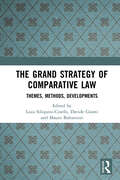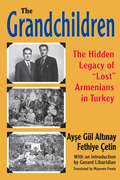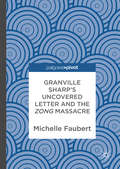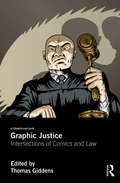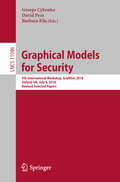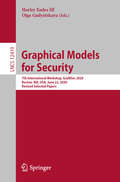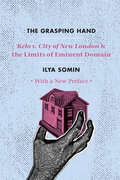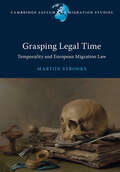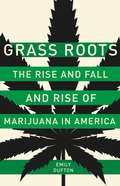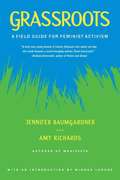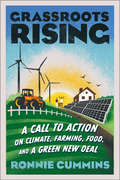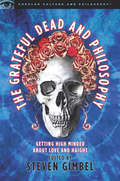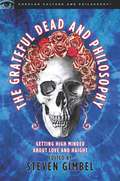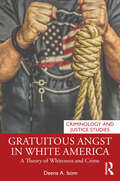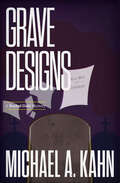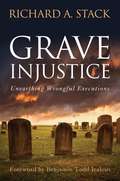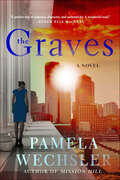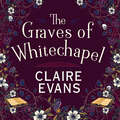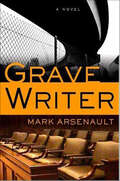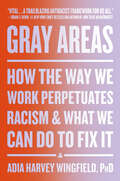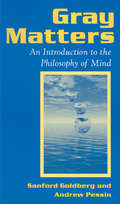- Table View
- List View
The Grand Strategy of Comparative Law: Themes, Methods, Developments
by Luca Siliquini-Cinelli Davide Gianti Mauro BalestrieriThis book features original essays by leading academics and emerging researchers written in honour of a legal comparatist who, over the course of four decades, has played a major role in comparative law’s development: Pier Giuseppe Monateri.Rather than being just a celebrative work without analytical appeal, this book makes a significant contribution to the comparative legal literature by exploring key comparative law themes and recent developments in the field. Reflecting Monateri’s vast expertise, innovative thinking, and truly global network, the volume is divided into five thematic areas of both scholarly and practical significance: Comparative Law and Its Methods; Comparative Private Law; Law and Literature; The Politics and Ontology of Law; Comparative Law & Economics. Discussing novel case-studies as well as exploring Monateri’s importance to the comparative enterprise through various trajectories of inquiry – for example, normative, doctrinal, empirical, critical – this book takes a fundamental and much-needed step towards the establishment of comparative law as a fully-fledged academic discipline and professional practice.Addressing the current status and future direction of comparative law, this book will appeal to legal comparativists, as well as students and scholars with broader interests in the nature of legal cultures.
The Grandchildren: The Hidden Legacy of 'Lost' Armenians in Turkey
by Ayse Gul AltinayThe Grandchildren is a collection of intimate, harrowing testimonies by grandchildren and great-grandchildren of Turkey's "forgotten Armenians"—the orphans adopted and Islamized by Muslims after the Armenian genocide. Through them we learn of the tortuous routes by which they came to terms with the painful stories of their grandparents and their own identity. The postscript offers a historical overview of the silence about Islamized Armenians in most histories of the genocide.When Fethiye cetin first published her groundbreaking memoir in Turkey, My Grandmother, she spoke of her grandmother's hidden Armenian identity. The book sparked a conversation among Turks about the fate of the Ottoman Armenians in Anatolia in 1915. This resulted in an explosion of debate on Islamized Armenians and their legacy in contemporary Muslim families.The Grandchildren (translated from Turkish) is a follow-up to My Grandmother, and is an important contribution to understanding survival during atrocity. As witnesses to a dark chapter of history, the grandchildren of these survivors cast new light on the workings of memory in coming to terms with difficult pasts.
Granville Sharp's Uncovered Letter and the Zong Massacre
by Michelle FaubertThis book delineates the discovery of a previously unknown manuscript of a letter from Granville Sharp, the first British abolitionist, to the “Lords Commissioners of the Admiralty.” In the letter, Sharp demands that the Admiralty bring murder charges against the crew of the Zong for forcing 132 enslaved Africans overboard to their deaths. Uncovered by Michelle Faubert at the British Library in 2015, the letter is reproduced here, accompanied by her examination of its provenance and significance for the history of slavery and abolition. As Faubert argues, the British Library manuscript is the only fair copy of Sharp’s letter, and extraordinary evidence of Sharp’s role in the abolition of slavery.
Graphic Artist's Guild Handbook of Pricing and Ethical Guidelines, Fourteenth Edition
by Graphic Artist's Guild StaffGraphic Artists Guild Handbook: Pricing & Ethical Guidelines, 14th Edition is an indispensable resource for people who create graphic art and those who buy it. As the graphic art marketplace continues to evolve to meet the needs of both digital and print media and as clients struggle with shrinking budgets in the current economy, the need for up-to-date information on business, ethical, and legal issues is greater than ever. Find it all here in the 14th Edition.
Graphic Justice: Intersections of Comics and Law
by Thomas GiddensThe intersections of law and contemporary culture are vital for comprehending the meaning and significance of law in today’s world. Far from being unsophisticated mass entertainment, comics and graphic fiction both imbue our contemporary culture, and are themselves imbued, with the concerns of law and justice. Accordingly, and spanning a wide variety of approaches and topics from an international array of contributors, Graphic Justice draws comics and graphic fiction into the range of critical resources available to the academic study of law. The first book to do this, Graphic Justice broadens our understanding of law and justice as part of our human world—a world that is inhabited not simply by legal concepts and institutions alone, but also by narratives, stories, fantasies, images, and other cultural articulations of human meaning. Engaging with key legal issues (including copyright, education, legal ethics, biomedical regulation, and legal personhood) and exploring critical issues in criminal justice and perspectives on international rights, law and justice—all through engagement with comics and graphic fiction—the collection showcases the vast breadth of potential that the medium holds. Graphic Justice will be of interest to academics and postgraduate students in: cultural legal studies; law and the image; law, narrative and literature; law and popular culture; cultural criminology; as well as cultural and comics studies more generally.
Graphical Models for Security: 5th International Workshop, GraMSec 2018, Oxford, UK, July 8, 2018, Revised Selected Papers (Lecture Notes in Computer Science #11086)
by George Cybenko David Pym Barbara FilaThis book constitutes revised selected papers from the 5th International Workshop on Graphical Models for Security, GraMSec 2018, held in Oxford, UK, in July 2018. The 7 full papers presented in this volume were carefully reviewed and selected from 21 submissions. The book also contains one invited talk. The contributions deal with the latest research and developments on graphical models for security.
Graphical Models for Security: 7th International Workshop, GraMSec 2020, Boston, MA, USA, June 22, 2020, Revised Selected Papers (Lecture Notes in Computer Science #12419)
by Harley Eades III Olga GadyatskayaThis book constitutes the proceedings of the 7th International Workshop on Graphical Models for Security, GramSec 2020, which took place on June 22, 2020. The workshop was planned to take place in Boston, MA, USA but changed to a virtual format due to the COVID-19 pandemic. The 7 full and 3 short papers presented in this volume were carefully reviewed and selected from 14 submissions. The papers were organized in topical sections named: attack trees; attacks and risks modelling and visualization; and models for reasoning about security.
The Grasping Hand: "Kelo v. City of New London" and the Limits of Eminent Domain
by Ilya SominIn 2005, the Supreme Court ruled that the city of New London, Connecticut, could condemn fifteen residential properties in order to transfer them to a new private owner. Although the Fifth Amendment only permits the taking of private property for public use, the Court ruled that the transfer of condemned land to private parties for economic development is permitted by the Constitution even if the government cannot prove that the expected development will ever actually happen. The Court s decision in "Kelo v. City of New London" empowered the grasping hand of the state at the expense of the invisible hand of the market. In this detailed study of one of the most controversial Supreme Court cases in modern times, Ilya Somin argues that "Kelo" was a grave error. Economic development and blight condemnations are unconstitutional under both originalist and most living constitution theories of legal interpretation. They also victimize the poor and the politically weak for the benefit of powerful interest groups and often destroy more economic value than they create. "Kelo" itself exemplifies these patterns. The residents targeted for condemnation lacked the influence needed to combat the formidable government and corporate interests arrayed against them. Moreover, the city s poorly conceived development plan ultimately failed: the condemned land lies empty to this day, occupied only by feral cats. The Supreme Court s unpopular ruling triggered an unprecedented political reaction, with forty-five states passing new laws intended to limit the use of eminent domain. But many of the new laws impose few or no genuine constraints on takings. The "Kelo "backlash led to significant progress, but not nearly as much as it may have seemed. Despite its outcome, the closely divided 5-4 ruling shattered what many believed to be a consensus that virtually any condemnation qualifies as a public use under the Fifth Amendment. It also showed that there is widespread public opposition to eminent domain abuse. With controversy over takings sure to continue, "The Grasping Hand" offers the first book-length analysis of Kelo by a legal scholar, alongside a broader history of the dispute over public use and eminent domain and an evaluation of options for reform. "
Grasping Legal Time: Temporality and European Migration Law (Cambridge Asylum and Migration Studies)
by Martijn StronksTime is one of the most important means for the exercise of power. In Migration Law, it is used for disciplining and controlling the presence of migrants within a certain territory through the intricate interplay of two overlapping but contradicting understandings of time – human and clock time. This book explores both the success and limitations of the usage of time for the governance of migration. The virtues of legal time can be seen at work in several temporal differentiations in migration law: differentiation based on temporality, deadlines, qualification of time and procedural differentiation. Martijn Stronks contests that, hidden in the usage of legal time in Migration Law, there is an argument for the inclusion of migrants on the basis of their right to human time. This assertion is based in the finite, irreversible and unstoppable character of human time.
Grass Roots: The Rise and Fall and Rise of Marijuana in America
by Emily DuftonHow earnest hippies, frightened parents, suffering patients, and other ordinary Americans went to war over marijuanaIn the last five years, eight states have legalized recreational marijuana. To many, continued progress seems certain. But pot was on a similar trajectory forty years ago, only to encounter a fierce backlash. In Grass Roots, historian Emily Dufton tells the remarkable story of marijuana's crooked path from acceptance to demonization and back again, and of the thousands of grassroots activists who made changing marijuana laws their life's work.During the 1970s, pro-pot campaigners with roots in the counterculture secured the drug's decriminalization in a dozen states. Soon, though, concerned parents began to mobilize; finding a champion in Nancy Reagan, they transformed pot into a national scourge and helped to pave the way for an aggressive war on drugs. Chastened marijuana advocates retooled their message, promoting pot as a medical necessity and eventually declaring legalization a matter of racial justice. For the moment, these activists are succeeding--but marijuana's history suggests how swiftly another counterrevolution could unfold.
Grassroots: A Field Guide for Feminist Activism
by Jennifer Baumgardner Amy RichardsFrom the authors of Manifesta, an activism handbook that illustrates how to truly make the personal political. Grassroots is an activism handbook for social justice. Aimed at everyone from students to professionals, stay-at-home moms to artists, Grassroots answers the perennial question: What can I do? Whether you are concerned about the environment, human rights violations in Tibet, campus sexual assault policies, sweatshop labor, gay marriage, or the ongoing repercussions from 9-11, Jennifer Baumgardner and Amy Richards believe that we all have something to offer in the fight against injustice. Based on the authors' own experiences, and the stories of both the large number of activists they work with as well as the countless everyday people they have encountered over the years, Grassroots encourages people to move beyond the "generic three" (check writing, calling congresspeople, and volunteering) and make a difference with clear guidelines and models for activism. The authors draw heavily on individual stories as examples, inspiring readers to recognize the tools right in front of them--be it the office copier or the family living room--in order to make change. Activism is accessible to all, and Grassroots shows how anyone, no matter how much or little time they have to offer, can create a world that more clearly reflects their values.
Grassroots Activism and the Evolution of Transitional Justice
by Iosif KovrasThe families of the disappeared have long struggled to uncover the truth about their missing relatives. In so doing, their mobilization has shaped central transitional justice norms and institutions, as this ground-breaking work demonstrates. Kovras combines a new global database with the systematic analysis of four challenging case studies - Lebanon, Cyprus, South Africa and Chile - each representative of a different approach to transitional justice. These studies reveal how variations in transitional justice policies addressing the disappeared occur: explaining why victims' groups in some countries are caught in silence, while others bring perpetrators to account. Conceiving of transitional justice as a dynamic process, Kovras traces the different phases of truth recovery in post-transitional societies, giving substance not only to the 'why' but also the 'when' and 'how' of this kind of campaign against impunity. This book is essential reading for all those interested in the development of transitional justice and human rights.
Grassroots Rising: A Call to Action on Climate, Farming, Food, and a Green New Deal
by Ronnie CumminsGrassroots Rising is a passionate call to action for the global body politic, providing practical solutions for how to survive—and thrive—in catastrophic times. Author Ronnie Cummins aims to educate and inspire citizens worldwide to organize and become active participants in preventing ecological collapse. This book offers a blueprint for building and supercharging a grassroots Regeneration Movement based on consumer activism, farmer innovation, political change, and regenerative finance—embodied most recently by the proposed Green New Deal in the US. Cummins asserts that the solution lies right beneath our feet and at the end of our forks through the transformation of our broken food system. Using regenerative agriculture practices that restore our agricultural and grazing lands, we can sequester massive amounts of carbon in the soil. Coupled with an aggressive transition toward renewables, he argues that we have the power to not only mitigate and slow down climate change, but actually reverse global warming. In synergy with the Sunrise Movement and the growing support of a Green New Deal, Grassroots Rising will impact millions of conscious consumers, farmers, and the general public during the crucial 2020 election year and beyond. This book shows that a properly organized and executed Regeneration Revolution can indeed offer realistic climate solutions while also meeting our everyday needs. If you’re wondering what you can do to help address the global climate crisis, joining the Regeneration Revolution might be the best first step. “[Grassroots Rising] is a ‘good news’ instructional book for Regeneration, a practical, shovel-ready plan of action for the United States and the world to transition to climate stability, peace, justice, health, prosperity, cooperation, and participatory democracy.” —Ronnie Cummins
The Grateful Dead and Philosophy
by Steve GimbelThis book is another one of those late-night Grateful Dead inspired dorm room conversations with friends . . . only this time it's your professors sitting cross-legged on the floor asking if anyone else wants to order a pizza.The Grateful Dead emerged from the San Francisco counter-culture movement of the late 1960s to become an American icon. Part of the reason they remain an institution four decades later is that they and their fans, the Deadheads, embody deviation from social, artistic, and industry norms. From the beginning, the Grateful Dead has represented rethinking what we do and how we do it. Their long, free-form jams stood in stark contrast to the three minute, radio friendly, formulaic rock that preceded them. Allowing their fans to tape and trade recordings of shows and distributing concert tickets themselves bucked the corporate control of popular music. The use of mind-altering chemicals questioned the nature of consciousness and reality. The practice of "touring," following the band from city to city, living as modern day nomads presented a model distinct from the work-a-day option assumed by most in our corporate dominated culture. As a result, Deadheads are a quite introspective lot.The Grateful Dead and Philosophy contains essays from twenty professional philosophers whose love of the music and scene have led them to reflect on different philosophical questions that arise from the enigma that is the Grateful Dead. Coming from a variety of perspectives, ancient and modern, Eastern and Western, The Grateful Dead and Philosophy considers how the Grateful Dead fits into the broader trends of American thought running through pragmatism and the Beat poets, how the parking lot scene with its tie-dyed t-shirt and veggie burrito vendors was both a rejection and embrace of capitalism, and whether Jerry Garcia and the Buddha were more than just a couple of fat guys talking about peace. The lyrics of the Grateful Dead's many songs are also the basis for several essays considering questions of fate and freedom, the nature-nurture debate, and gamblers' ethics.
The Grateful Dead and Philosophy: Getting High-Minded about Love and Haight
by Steven GimbelTwenty philosophical essays about the Grateful Dead phenomenon evaluates the band, its lyrics, and its influence from a variety of ancient and modern perspectives to consider how it fits into broader trends of American thought.
Gratuitous Angst in White America: A Theory of Whiteness and Crime (Criminology and Justice Studies)
by Deena A. IsomGratuitous Angst in White America presents a new criminological theory that explains the racialized experiences of white people. Unlike orthodox traditions that assume whiteness as normative or progressive traditions that center the experiences of the marginalized and oppressed, the theory of whiteness and crime flips those perspectives and turns a lens toward white people’s lived experiences and the ideologies of whiteness. The theory of whiteness and crime answers two overarching questions: How does being white impact one’s likelihood of engaging in deviant, criminal, and/or violent behaviors? And, why are white people treated differently than other racial and ethnic groups by the criminal legal system? Through the application of a critical whiteness perspective to criminology, the theory of whiteness and crime is an intersectional and integrated framework that explains within (and between) group differences in negative behaviors and entanglements with the criminal legal system.This book examines the racialized history of America to contextualize the current racial strife in society and inform a more nuanced theoretical approach to explaining disparities. The reader will gain a socio-historical understanding of the depths of the current divides and insight into how such are perpetuated and potentially dismantled. Students will see connections between various theoretical traditions and an application of theory to current social conditions. Researchers will acquire a new theoretical foundation and propositions to ground empirical work that will fill extensive gaps in the criminological literature. And policy makers will see how oversights in understanding the depths of historical significance perpetuate and increase disparities and disadvantages, which are counter to a pursuit of justice.Written in a compelling and direct way, this book will appeal to those in criminology, sociology, race and ethnic studies, gender and sexuality studies, political science, cultural studies, psychology, criminal justice, law, and beyond. Gratuitous Angst in White America is essential for those seeking a more complete understanding of the associations between race and crime and those who want to remedy those disparities. In the end, it is more than a new theory of crime, it is a call to action for all willing to hear.
Grave Designs: A Rachel Gold Mystery (Attorney Rachel Gold Mysteries #1)
by Michael A. Kahn"With an ear for intelligent, breezy dialogue and clever plotting, Kahn spins an engrossing yarn." —Publishers WeeklyWhen Graham Anderson Marshall III of the prestigious corporate law firm Abbott & Windsor dies, even stranger than his bizarre death is the codicil to his will, which provides a large trust fund for the maintenance of a grave at a pet cemetery. The issue? No one in his family has ever owned a pet—much less one named Canaan. And since Abbott & Windsor is named as the sole beneficiary if the trust is deemed invalid, there is a conflict of interest.They turn to Rachel Gold, the savvy young attorney who left the firm to open her own law office. But before she has a chance to find out what is inside Canaan's coffin at Wagging Tail Estates, the grave is robbed. Teaming up with her best buddy, the brilliant Benny Goldberg, Rachel sets out in search of the stolen contents, following an ominous trail of clues which leads into the heart of a secret legacy of three centuries of blackmail, sexual depravity, and murder. While tracking whatever had been in Canaan's grave, it's soon apparent to Rachel that someone has plans for hers...
Grave Injustice: Unearthing Wrongful Executions
by Richard A. StackOn September 21, 2011, the controversial execution of Georgia inmate Troy Davis, who spent twenty years on death row for a crime he most likely did not commit, revealed the complexity of death penalty trials, the flaws in America’s justice system, and the rift between those who are for or against the death penalty. Davis’s execution reignited a long-standing debate about whether the death penalty is an appropriate form of justice. In Grave Injustice Richard A. Stack seeks to advance the anti–death penalty argument by examining the cases of individuals who, like Davis, have been executed but are likely innocent. By telling the stories of Jesse Tafero, Ruben Cantu, Carlos DeLuna, Cameron Todd Willingham, Larry Griffin, and others, Stack puts a human face on the ultimate and irrevocable tragedy of capital punishment. Although polls indicate Americans favor death sentences approximately three to one, many respondents change their position when presented with the facts about capital punishment. Stack’s compelling descriptions of nineteen wrongful executions illustrate the flaws of the death penalty, which, he argues, is ineffective in deterring crime and costs more than sentences of life without parole. He demonstrates that racial disparities in implementation, procedural errors, incompetent defense attorneys, and mistaken eyewitness identification lead to an alarming number of wrongful convictions. But influencing public opinion is only part of the battle to end state-sanctioned killing. Stack profiles six anti–death penalty warriors, demonstrating the range of what can be done, and what remains to be done, to move toward a more compassionate society.
The Graves: A Novel (The Abby Endicott Novels #2)
by Pamela WechslerAbby Endicott, the chief of the District Attorney’s homicide unit in Boston, returns in the heart-racing follow-up to Mission Hill. Things are looking good for Abby: she’s top pick to be the next District Attorney, and her musician boyfriend Ty has moved in, despite her upper crust family’s objections. But a serial killer is on the loose, and with two college-aged girls dead and another missing, time is running out. When the sons of a prominent government official are linked to the murders, Abby pushes back, stopping at nothing to find justice for the girls. This time, the killer could be right under her nose, and she may be the next victim.In The Graves, former prosecutor turned television writer Pamela Wechsler delivers a tense and enthralling Boston-set thriller about the intersection of power, privilege, and justice.
The Graves of Whitechapel: A darkly atmospheric historical crime thriller set in Victorian London
by Claire Evans'An enthralling read' -- DAILY MAILIn the gripping new novel by the author of The Fourteenth Letter, a lawyer in Victorian London must find a man he got off a murder charge - and who seems to have killed again . . . Victorian London, 1882.Five years ago, crusading lawyer Cage Lackmann successfully defended Moses Pickering against a charge of murder. Now, a body is found bearing all the disturbing hallmarks of that victim - and Pickering is missing. Cage's reputation is in tatters, and worse, he is implicated in this new murder by the bitter detective who led the first failed case. Left with no other alternative, Cage must find Pickering to prove his innocence. Did Cage free a brutal murderer? Or is there something more sinister at work?PRAISE FOR CLAIRE EVANS'A darkly brilliant romp packed with intrigue and romance . . . curl up and prepare to become immersed'Heat'Exuberant plotting and witty prose. Great fun'The Times'Claire Evans has created a cast of deliciously sinister and mysterious characters. A hugely satisfying read'Good Housekeeping'If you enjoyed Kate Mosse's Labyrinth or Jessie Burton's The Miniaturist, then chances are you're going to love this new thriller' Hello Magazine
The Graves of Whitechapel: A darkly atmospheric historical crime thriller set in Victorian London
by Claire Evans'An enthralling read' -- DAILY MAILIn the gripping new novel by the author of The Fourteenth Letter, a lawyer in Victorian London must find a man he got off a murder charge - and who seems to have killed again . . . Victorian London, 1882.Five years ago, crusading lawyer Cage Lackmann successfully defended Moses Pickering against a charge of murder. Now, a body is found bearing all the disturbing hallmarks of that victim - and Pickering is missing. Cage's reputation is in tatters, and worse, he is implicated in this new murder by the bitter detective who led the first failed case. Left with no other alternative, Cage must find Pickering to prove his innocence. Did Cage free a brutal murderer? Or is there something more sinister at work?PRAISE FOR CLAIRE EVANS'A darkly brilliant romp packed with intrigue and romance . . . curl up and prepare to become immersed'Heat'Exuberant plotting and witty prose. Great fun'The Times'Claire Evans has created a cast of deliciously sinister and mysterious characters. A hugely satisfying read'Good Housekeeping'If you enjoyed Kate Mosse's Labyrinth or Jessie Burton's The Miniaturist, then chances are you're going to love this new thriller' Hello Magazine
Gravewriter: A Novel (Billy Povich #1)
by Mark Arsenault"Even better than his Shamus-finalist debut, Spiked." ---Publishers Weekly (starred review) on Speak Ill of the LivingHighly praised by both reviewers and mystery writers, Mark Arsenault introduces a stunning new suspense series with his courtroom drama, Gravewriter.Billy Povich used to be a journalist. He lost his wife because of his gambling habit, and then she died in a car crash. Now he finds himself writing obituaries and living with his elderly father and seven-year-old son, Bo.Billy plans to kill the man who was at the wheel the night of his wife's death. But then a summons to jury duty for a murder trial delays Billy's agenda. As the trial heats up, Billy finds that his little boy spots danger faster than he does, and a frantic and deadly chase begins with Billy as the prey.
Gray Areas: How the Way We Work Perpetuates Racism and What We Can Do to Fix It
by Adia Harvey WingfieldGray Areas has descriptive copy which is not yet available from the Publisher.
Gray Matters: Introduction to the Philosophy of Mind
by Andrew Pessin Sanford GoldbergGray Matters is a thorough examination of the main topics in recent philosophy of mind. It aims at surveying a broad range of issues, not all of which can be subsumed under one position or one philosopher's theory. In this way, the authors avoid neglecting interesting issues out of allegiance to a given theory of mind.
Gray Mountain: A Bestselling Thrilling, Fast-Paced Suspense Story
by John Grisham'No one does it better than Grisham' - TelegraphDonovan Gray is ruthless and fearless. Just the kind of lawyer you need, deep in small-town Appalachia.Samantha Kofer is a world away from her former life at New York's biggest law firm. If she is going to survive in coal country, she needs to start learning fast.Because as Donovan knows only too well, the mountains have their own laws. And standing up for the truth means putting your life on the line . . .What readers are saying about GRAY MOUNTAIN'The worst kind of corporate exploitation of the poor in rural areas is exposed . . . Absolute suspense and drama filled the pages' - 5 STARS'Such a good read' - 5 STARS'Thoroughly enjoyed every word, sentence and page!' - 5 STARS 350+ million copies, 45 languages, 9 blockbuster films:NO ONE WRITES DRAMA LIKE JOHN GRISHAM
